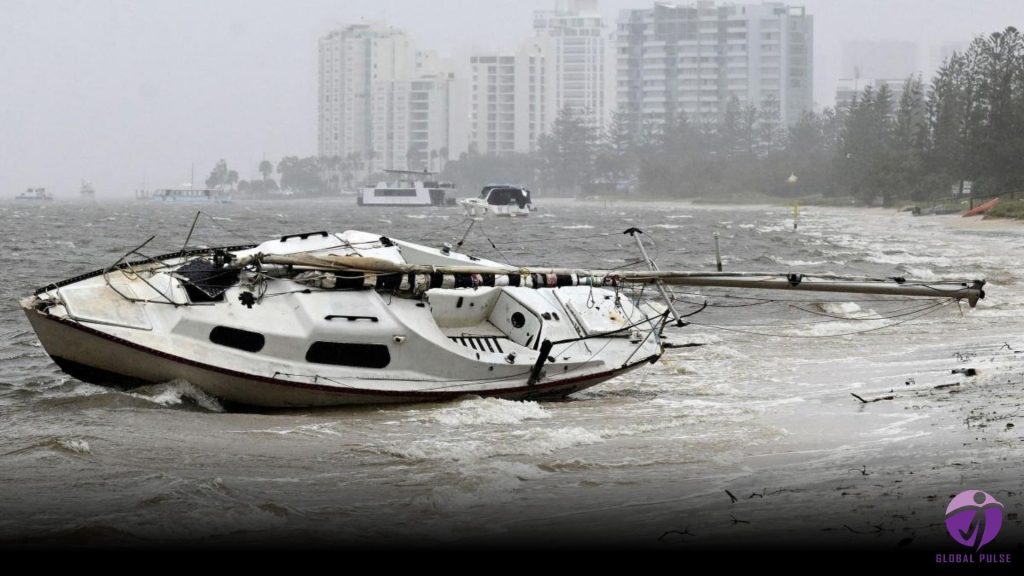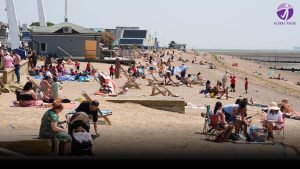Australian authorities say a body has been found in floodwaters and 13 military workers injured in a vehicle crash as wild weather from a tropical storm lashes the country’s eastern coast.
Cyclone Alfred, downgraded to a tropical low, made landfall near Brisbane, the capital of Queensland, on Saturday evening local time.
Authorities have issued a caution to residents, advising them to stay indoors and maintain a state of alert and emphasising that the danger posed by the storm is “not over.”
Winds have brought down trees and power lines and flooded low-lying roads. Over 300,000 properties in the region are currently experiencing power outages.
Police said on Saturday they had discovered a body in the search for a 61-year-old man who went missing on Friday after his car was caught in floodwaters in Dorrigo, northern New South Wales (NSW).
Emergency responders observed as the man fled his vehicle and ascended a tree by the riverbank; however, rescuers were unable to reach him in time before the current carried him away.
Authorities discovered a body in the vicinity on Saturday, stating that it “is believed to be that of the missing man.”
In a separate incident on Saturday, 13 military personnel were injured in a convoy crash in Lismore, about 200km south of Brisbane, according to Federal Defence Personnel Minister Matt Keogh.
A truck overturned while navigating a narrow road. A subsequent truck subsequently crashed into it.
The state ambulance service reported that it attended to 36 individuals involved in the accident. Keogh informed the press that approximately 36 individuals were involved in the incident, with only 13 sustaining injuries.
Military crews were deployed to Lismore near the Queensland border to assist with rescue and response operations.
Prime Minister Anthony Albanese issued a statement highlighting the commitment of the Australian Defence Force, noting that some members had sustained serious injuries while en route to assist Australians in need.
On Saturday, Albanese delivered a national address from Canberra, emphasising that while millions of residents are “well-prepared,” it is crucial to “remain vigilant.”
As the storm approaches, four million residents in Queensland and northern New South Wales are preparing for its impact, with numerous weather warnings issued throughout the regions.
Energy provider Energex reported that approximately 287,000 customers in southeast Queensland are currently facing outages. Meanwhile, Essential Energy has indicated that over 42,600 homes and businesses in New South Wales have been affected by blackouts.
As they went to bed on Friday, residents of Brisbane, the capital of Queensland, prepared for a night of strong winds and heavy rain.
They woke on Saturday to learn that the cyclone had been downgraded and the city would escape the worst weather.
But the danger’s not over in other parts of southeastern Queensland and northern New South Wales.
Along the Gold Coast, pummelled by bad weather the past few days, conditions have been extreme, driving rain and strong winds.
Hundreds of trees have been blown over in gardens, parks, and along the main roads. Due to the significant amount of debris, emergency services have cordoned off areas deemed most at risk.
New South Wales state premier Chris Minns emphasised that the emergency remains ongoing, stressing the “crucially important” need for the public to avoid “dismissing” the storm.
“It doesn’t matter to us whether it’s been downgraded from a tropical cyclone to a weather event,” he said.
The state’s emergency service operations commander, Stuart Fisher, warned people not to be “complacent” and said authorities in the region expect flooding to continue over the next few days.
With the storm approaching landfall, nearly 1,000 schools have been closed, public transport has been suspended, and airports are now shut down. Elective surgeries have also been cancelled.
Flights are not expected to resume until Sunday at the earliest.
The BBC spoke to several people from Brisbane’s homeless community, who took refuge at Emmanuel City Mission, which had become a round-the-clock shelter.
At the Treasure Island Holiday Park on the Gold Coast, just north of Surfer’s Paradise, a gum tree had come down between two cabins, damaging a third. Nearby, a boat was half submerged in one of the canals a block away from the beach.
Access to the beach has become increasingly difficult, as numerous paths leading down to the shoreline are now impassable. Instead, there’s a sudden drop to the ocean, where the mighty waves have eaten away at the sand.
But the clean-up operation will take a few days—the wind is still powerful, and there’s driving rain.
As residents begin to assess the extent of the damage, many opt to stay indoors for their safety.













